Got tiny bugs buzzing around your kitchen? You might have fruit flies! Don’t worry, these common pests are more of a nuisance than a major problem. The good news is, you don’t need to spend a lot of money or use harsh chemicals to get rid of them. You probably already have everything you need right in your kitchen. Recently, we had a fruit fly invasion at home (the first time in years, and we have no idea where they came from!). It was the perfect opportunity to put different fruit fly elimination methods to the test. Yes, there were notes taken, and even a spreadsheet involved! Today, I’m sharing the best homemade fruit fly traps and how you can easily make them.
These DIY traps are incredibly easy to assemble using natural ingredients you likely already have. Consider this a super DIY-friendly and chemical-free approach. And if you’re feeling kind, we’ll even explore humane options for releasing them outside rather than… the alternative. We’ll also cover some essential tips to prevent fruit flies from setting up shop in your home in the first place.
What Exactly Are Fruit Flies?
Fruit flies are those tiny flying insects that are drawn to sweet fruits and vegetables – their name is a pretty big hint! They’re also attracted to anything sugary or fermented, like beer, wine, and juice. You’ll often see them hanging around fruit bowls, garbage cans, and even kitchen sink drains. They’re about the size of a grain of rice and look like miniature, tan or brownish houseflies, often with noticeable red eyes. They tend to be most prevalent in the warmer months, like summer and late fall, when fruits are abundant.
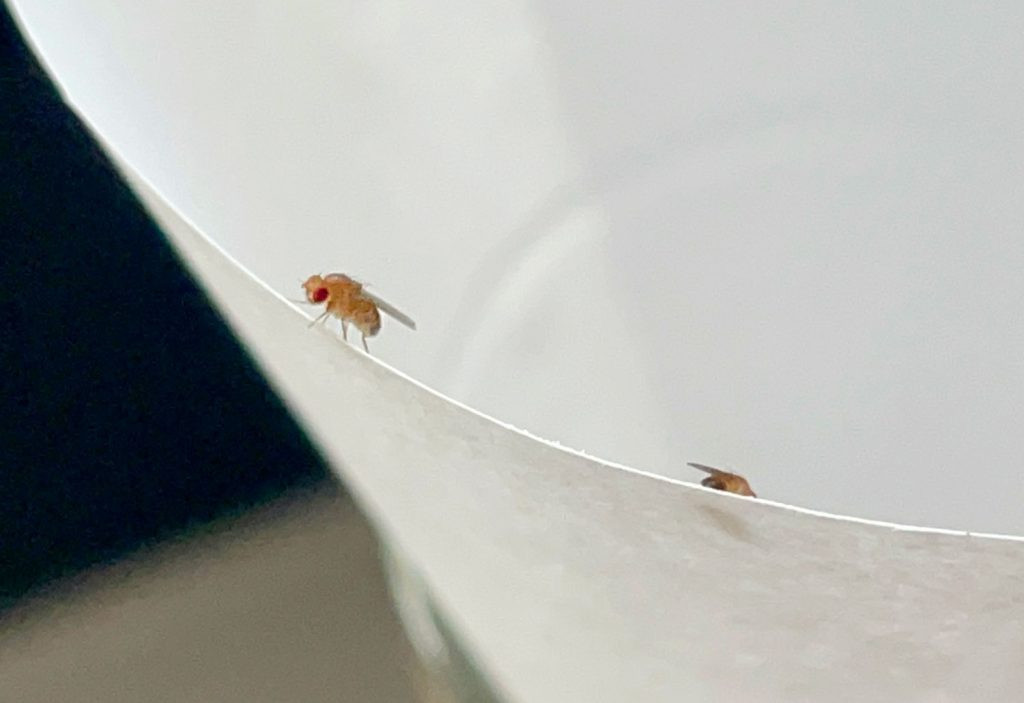 Close Up Of Fruit Fly On Paper Funnel
Close Up Of Fruit Fly On Paper Funnel
A fruit fly problem can start with just a few hitchhikers that sneak into your home on a piece of fruit. But here’s the thing: female fruit flies can lay hundreds of eggs in their short lifespans, and these eggs can hatch in as little as 12 hours. They can become adults in just a few days, meaning a small number of fruit flies can quickly turn into a full-blown infestation. That’s why it’s important to act fast and get rid of fruit flies as soon as you notice them.
Fruit Flies, Fungus Gnats, and Drain Flies: Spotting the Difference
Fruit flies are often mistaken for other tiny household pests, especially fungus gnats and drain flies. All three are small flying insects, but identifying them correctly is key to choosing the most effective removal method. The easiest way to tell them apart is by where you see them and what larger insect they resemble.
- Fruit flies look like miniature flies. You’ll find them near fruit bowls, garbage, or any source of fermenting food smells.
- Drain flies look like small, fuzzy moths. They are usually spotted near sinks and drains.
- Fungus gnats resemble small mosquitos. They are typically found around houseplants, as they breed in damp potting soil.
If you’re not completely sure which pest you’re dealing with, try one of the traps below. If it attracts the bugs in your home, you’ve likely got fruit flies!
4 Simple DIY Fruit Fly Traps
Getting rid of fruit flies doesn’t have to be complicated or expensive. You probably have everything you need already. Each trap works on the same basic principle: attract the fruit flies and then prevent them from escaping. We tested the following 4 DIY methods and definitely found a clear winner. But since each method uses common household items, trying more than one won’t hurt. Think of yourself as a fruit fly scientist – it can actually be a little fun, trust me! Here are the first 4 methods we tried:
- Funnel Trap
- Plastic Wrap Trap
- Dish Soap Trap
- Rotting Fruit Trap
I’ll go into more detail about each method below, and share our verdict on which worked best at the end. Just keep in mind that some traps work faster than others, and it might take a few days to completely eliminate your fruit fly problem.
#1: The Paper Funnel Fruit Fly Trap
This trap lures fruit flies into a container through a tiny opening at the bottom of a paper funnel. The flies can easily get in, drawn by the scent, but struggle to find their way back out through the small hole.
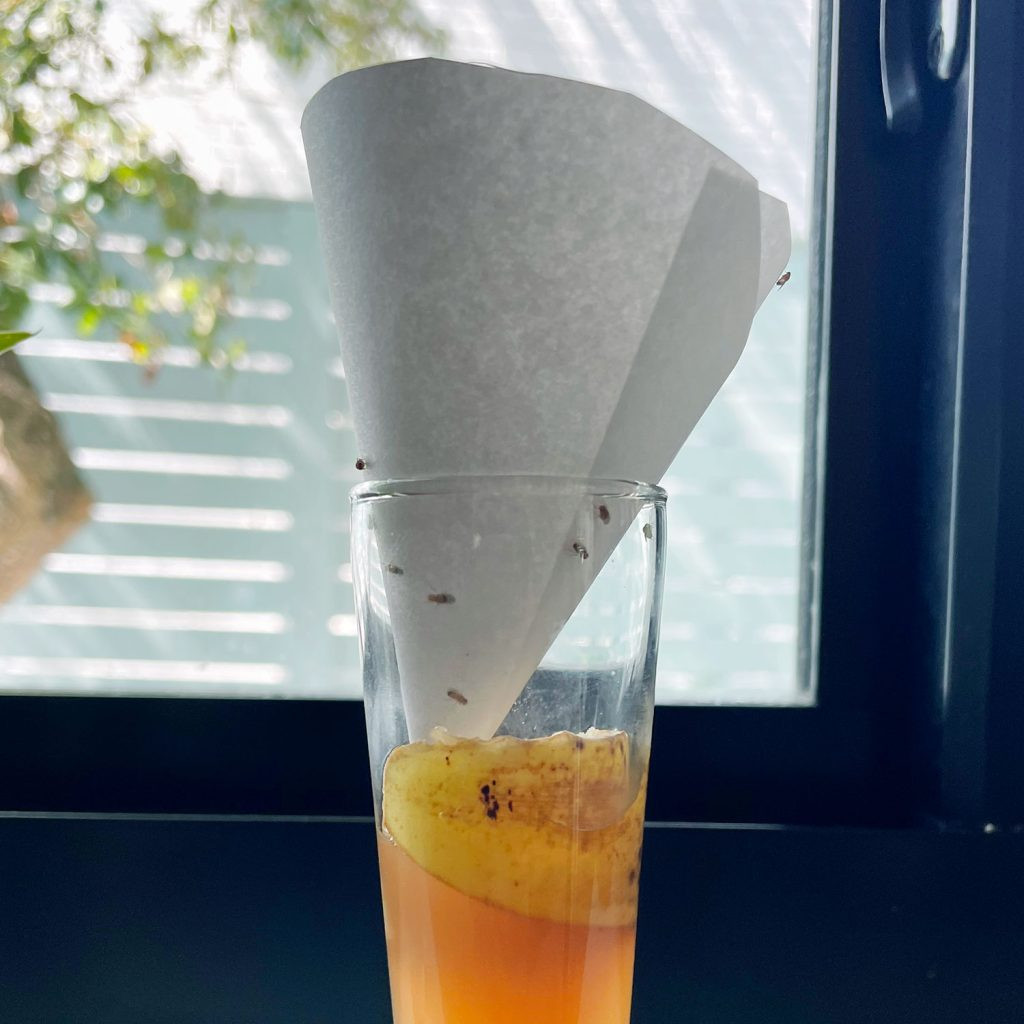 DIY Fruit Fly Trap With Paper Funnel
DIY Fruit Fly Trap With Paper Funnel
Supplies you’ll need:
- Small clear jar, cup, or container, ideally with a narrow opening
- Piece of paper or cardstock
- Tape
- Scissors
- Apple cider vinegar (ACV)
Instructions:
- Choose your container. Find a small, clear container like a used food jar or a plastic bottle. A narrow opening is helpful for this method.
- Add apple cider vinegar. Pour a small amount of apple cider vinegar, old beer, or wine into the bottom of the container. The enticing smell will attract the fruit flies.
- Make your funnel. Roll a piece of paper or cardstock into a cone shape, ensuring a very small opening at the pointed tip. Secure the cone shape with tape. You can also cut the small opening after forming the cone if that’s easier. The opening should be about the size of a grain of rice.
- Set up your funnel. Place the paper cone into the opening of your container. You might need to adjust the funnel shape so it sits securely on the rim of the container without touching the liquid. Ensure it fits snugly against the edges, preventing flies from escaping through any gaps.
- Humane Release (Optional). Carefully take the entire trap outside without disturbing the funnel (or the flies will escape!). Once outside, remove the funnel and let the trapped fruit flies fly away.
While you could use a store-bought funnel, the opening at the bottom is often too large, making it easier for fruit flies to escape. A homemade paper funnel with a tiny opening is much more effective.
#2: The Plastic Wrap Fruit Fly Trap
This trap also uses the irresistible scent of apple cider vinegar to attract fruit flies. They enter through tiny holes poked in the plastic wrap covering the top of the container, but then have difficulty escaping, similar to the funnel trap.
Supplies you’ll need:
- Small clear jar, cup, or container
- Rubber band
- Plastic wrap or a plastic bag
- Toothpick
- Apple cider vinegar (ACV)
Instructions:
The steps for the plastic wrap trap are very similar to the funnel trap:
- Choose your container. Select a small, clear jar, cup, or any glass container. Almost anything works, and it doesn’t need to be large. A clear container makes it easier to see how many flies you’re catching, but even an old can will work.
- Add apple cider vinegar. Pour apple cider vinegar into your container. The strong scent will attract the fruit flies. Old beer or wine also work well, but regular white vinegar is not as effective.
- Cover with plastic wrap. Stretch plastic wrap tightly over the opening of the container and secure it with a rubber band. Saran wrap is perfect, but you can also use a piece cut from a plastic bag.
- Poke small holes. Use a toothpick to carefully poke a few small holes in the plastic wrap top. You don’t need many holes, but make sure they’re large enough for a fruit fly to get through.
- Humane Release (Optional). Take the entire trap outside carefully, keeping the plastic wrap cover in place. Once outdoors, remove the plastic wrap and let the fruit flies escape.
Alternatively, you can adapt this method by poking holes in the lid of a metal jar lid instead of using plastic wrap. Use a mason jar or an old food jar with a metal lid. Use a hammer and nail to create small holes in the lid.
#3: The Dish Soap Fruit Fly Trap
Unlike the previous traps, this method doesn’t require a cover. Instead, it uses the surface tension of soapy water to trap the fruit flies. Important note: this method is not humane as the soap will trap and likely kill the flies.
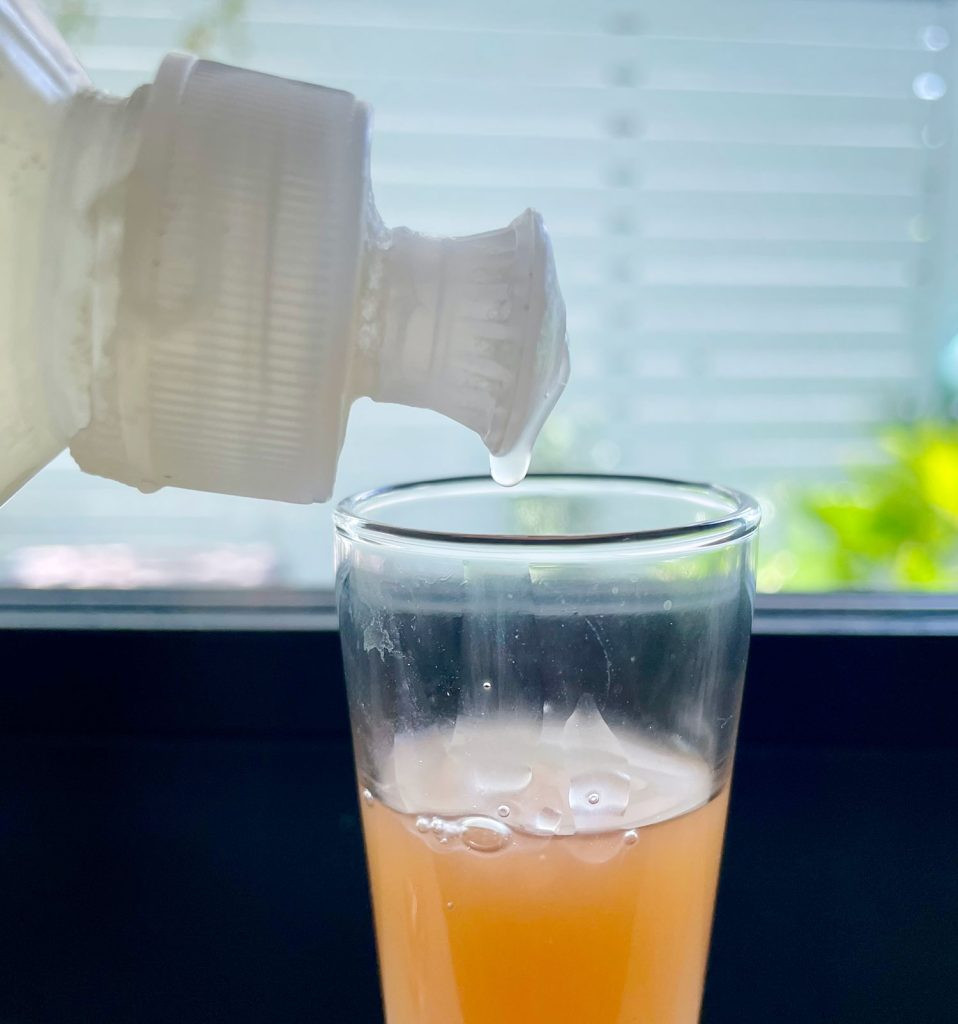 Dripping Dish Soap Into Apple Cider Vinegar For DIY Fruit Fly Trap
Dripping Dish Soap Into Apple Cider Vinegar For DIY Fruit Fly Trap
Supplies you’ll need:
- Small container, bowl, or dish
- Dish soap
- Apple cider vinegar (ACV)
Instructions:
This trap is incredibly simple to make:
- Pour in apple cider vinegar. Just like the other traps, fill the bottom of a small container, bowl, or dish with apple cider vinegar. The scent will attract the fruit flies.
- Add dish soap and mix. Add a few drops of dish soap to the apple cider vinegar and gently mix to create a soapy solution. Fruit flies will be attracted to the vinegar, land on the surface, and the soap will prevent them from flying away by breaking the surface tension of the liquid.
You can also combine this dish soap method with the plastic wrap or funnel traps. Simply add a few drops of dish soap to the apple cider vinegar before covering the container. This adds an extra way for the flies to get trapped.
#4: The Rotting Fruit Fruit Fly Trap
We also experimented with traps that swapped out apple cider vinegar for what fruit flies love even more: actual fruit!
Supplies you’ll need:
- Small glass jar, cup, or container
- Plastic wrap or paper funnel (depending on which trap style you choose)
- A small piece of fruit, like a banana peel or apple slice
To make a rotting fruit trap, simply replace the apple cider vinegar with a piece of ripe banana peel, apple slice, or peach in either the Plastic Wrap or Funnel trap method. You can also add a piece of fruit to your apple cider vinegar trap to make it even more enticing. Just remember to replace the fruit every day or two to prevent unwanted odors in your kitchen as it gets too ripe.
The Verdict: The Best DIY Fruit Fly Trap
As you can see in the photos, we set up 4 different DIY traps to test their effectiveness. The four homemade traps we tested were:
- Plastic Wrap Trap with banana peel
- Funnel Trap with ACV + banana peel
- Plastic Wrap Trap with ACV + dish soap
- Dish Soap Trap with ACV
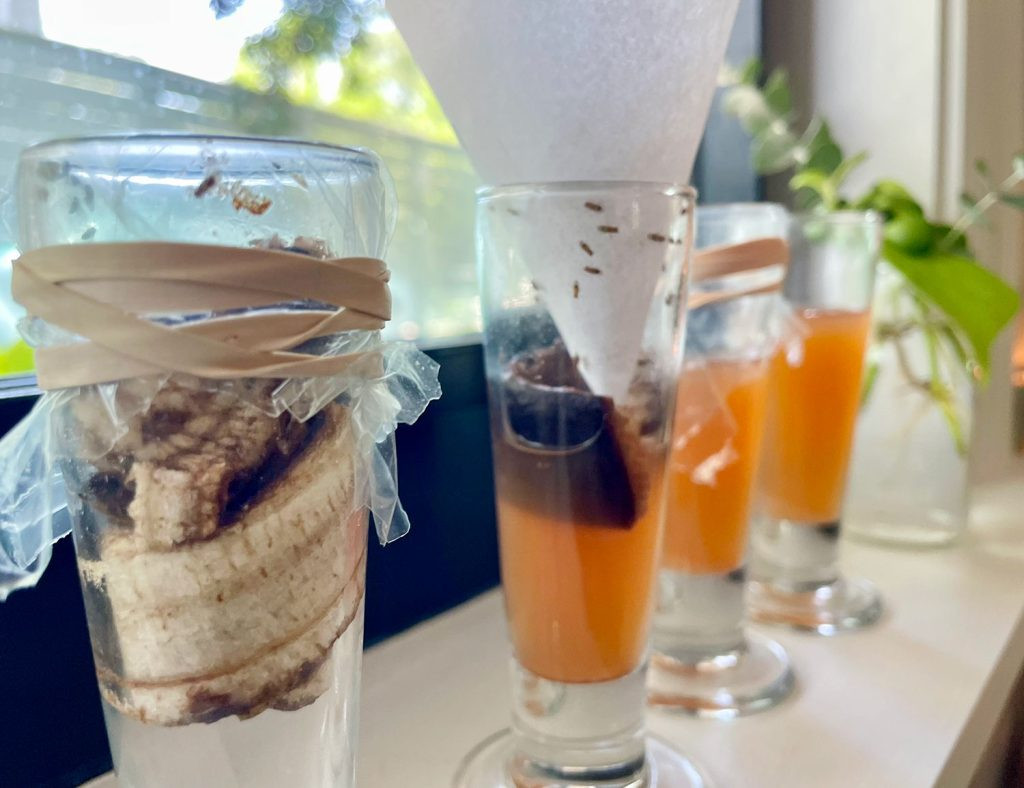 4 DIY Fruit Fly Traps Close Up
4 DIY Fruit Fly Traps Close Up
For us, the most important factor wasn’t the type of trap itself, but the bait we used. Traps with banana peel worked significantly better than those with just apple cider vinegar. Our two Plastic Wrap Traps were almost identical in design, but the one with banana peel caught dramatically more fruit flies than the one with ACV and soap. Maybe apple cider vinegar is less appealing when there’s real fruit nearby?
So, our recommendation is – no matter which trap you choose to make – add a piece of fruit to it! We slightly preferred the plastic wrap trap because it was easier to assemble and less prone to accidents. I accidentally bumped the funnel trap once and released a bunch of flies back into the kitchen – oops!
What Bait Attracts Fruit Flies the Most?
This is where my inner scientist got excited and I continued our little experiment. Since fruit scraps worked so well, we wanted to find out which type of fruit is the best bait. We tested three fruits we already had: banana peel, apple slices, and a strawberry. We placed each in a Plastic Wrap Trap side-by-side on our counter for 24 hours.
While the banana peel started out strong (it was the ripest fruit to begin with), the fruit flies were ultimately most attracted to the strawberry. The banana peel still caught a good number of flies, but the longer the strawberry sat and ripened, the more flies it trapped. Surprisingly, the apple slices didn’t catch a single fruit fly!
Store-Bought Fruit Fly Traps: Are They Worth It?
If DIY traps aren’t working for you, or if you’d prefer a ready-made solution, there are commercially available fruit fly traps you can purchase. Many have thousands of positive reviews and cost under $20. They might be worth considering if you want something that also catches other types of flying insects, or if you prefer a trap that’s less noticeable than a DIY setup.
 Collage of Storebought Fruit Fly Traps
Collage of Storebought Fruit Fly Traps
During our experiment, I bought a pack of Terro Fruit Fly Traps to see how they compared to our homemade traps. I placed one next to our banana and strawberry traps for 24 hours to see which of the three performed best.
Again, our homemade strawberry trap came out on top, closely followed by the banana peel trap. The store-bought trap only caught a single fruit fly in that initial 24-hour period. HOWEVER…
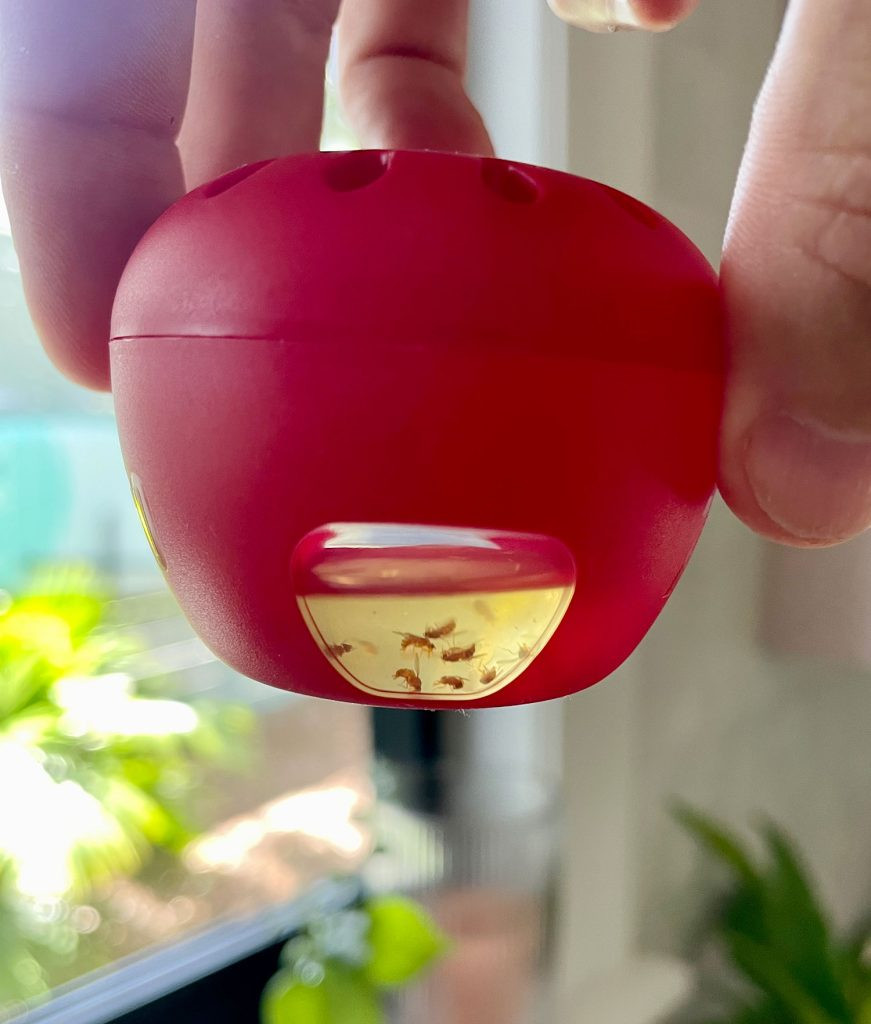 Terro Fruit Fly Trap With Dead Fruit Flies Visible
Terro Fruit Fly Trap With Dead Fruit Flies Visible
To be completely fair, we removed our DIY traps and left the store-bought Terro trap out for another 24 hours. That’s when it caught the impressive collection of fruit flies you see above. So, store-bought traps definitely work, but they might not be as immediately effective or as fast-acting as our homemade traps. Our final verdict? Use store-bought traps if you want a more discreet option, especially if you plan to leave it out long-term. But for quickly tackling a fruit fly problem, homemade traps are the way to go!
How To Prevent Fruit Flies From Coming Back
Getting rid of fruit flies is relatively easy, but preventing them from invading in the first place is even better. Here are some simple steps you can take to prevent fruit flies from making your home their home:
- Keep kitchen surfaces clean. Regularly wipe down counters, stovetops, tables, and any surfaces that might have food residue or spilled liquids. Fruit flies are especially attracted to fruit, sweet juices, and alcohol, so don’t let spills linger!
- Take out the trash frequently. Food scraps left in your garbage can overnight can quickly become a breeding ground for fruit flies.
- Dispose of overripe fruit promptly. Keep an eye on your fruit bowl and get rid of browning or rotting fruit before it becomes an attractant.
- Wash fruit and vegetables as soon as you bring them home. Washing produce immediately (except for berries, which can spoil faster with moisture) can remove any fruit fly eggs or larvae that might have hitched a ride from the store.
- Store produce in the refrigerator whenever possible. Fruit flies don’t thrive in cold temperatures, so refrigerating fruits and vegetables is a great preventative measure.
- Clean your sink drain regularly. Food particles trapped in your sink drain can also attract fruit flies. Run your garbage disposal and/or flush the drain with hot water regularly.
Finally, don’t panic when you see fruit flies in your house. Yes, you should act quickly to prevent the problem from getting worse, but the solutions in this article are easy, effective, and fast-acting. You might even enjoy becoming a fruit fly scientist for a little while, just like I did!
This post contains affiliate links, so we may earn a small commission when you make a purchase through links on our site at no additional cost to you.